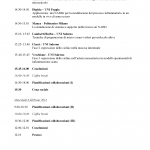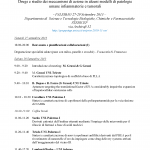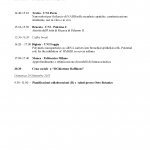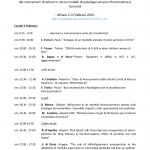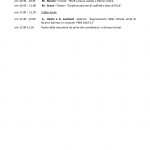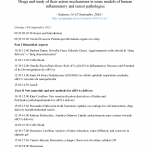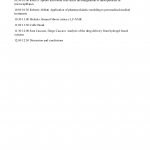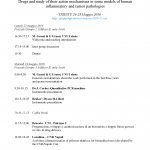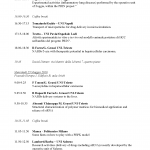|
Title
Identification of optimal delivery systems for the Nucleic Acid Based Drugs and study of the action mechanisms in some models of human tumoral and inflammatory pathologies
Principal Investigator: Mario Grassi
Abstract
For hepatocellular carcinoma, prostate adenocarcinoma, coronary restenosis, abdominal aortic aneurism, inflammatory bowel and lung diseases, a significant improvement in the efficacies of the therapeutic approaches so far available is urgently required. The use of “nucleic acid based drugs” (NABDs), a novel and emergent class of molecules, is considered very promising. However, a limitation in NABD use as drugs depends on the lack of optimal delivery systems able to minimize NABD degradation in the biological fluid and allow the targeting to the diseased tissue.
The aim of this project is to develop novel delivery systems for NABDs, appropriate for the considered human pathologies. Our approach will take into consideration the different problematics related to the engineering field, but also chemical, pharmaceutical and biomedical filed. Nine University groups will take part to the project together with eigtheen other non-University research groups.
Research units
| Unit | Team manager | Activities |
| 01. UNITS | Mario Grassi | Read More
|
| 02. UNISA | Gaetano Lamberti | Read More
|
| 03. UNIPV | Piersandro Pallavicini | Read More
To individuate an efficient therapy for hepatocellular carcinoma we will study the delivery NABDs, developed by Unit 01, by means of nanovectors based on gold asymmetric branched nanoparticles (ABN) and on spherical magnetite nanoparticles (MNP). |
| 04. UNINA | Stefano Guido | Read More
The activity is focused on the study of the interaction between human blood cells, in particular red blood cells, and either vessel walls or micro/nano particles, developed by the other Unit, for NABD delivery. |
| 05. CNR NA | Domenico Larobina | Read More
The aim is to support the other research units involved in the project with appropriate structural information on the gel systems employed in the release of NABD. For this specific purpose, we will adopt both mechanical and spectroscopic techniques. Such characterizations represent a useful support to set up the specific polymeric device able to release NABDs. |
| 06. UNIPA1 | Gennara Cavallaro | Read More
We will produce and characterize NABD delivery systems appropriate for the pathological conditions proposed by Units 01, 02 and 08; in particular we will evaluate:
|
| 07. UNIPA2 | Valerio Brucato | Read More
We will prepare polymeric scaffolds (made of PLLA and/or PLLA/PLA mixtures) pre-angiogenized as from proprietary patent, and will carry out advanced “in vitro” tests on the NABD release. PLLA scaffold, featuring a pseudo-vascular structure, prepared as for the proprietary patent, will be cultured with mixed population of mesenchymal cells (to promote the ECM formation) and tumoral cells (of interest for the pathologies of this project) showing different metastatic strenght to generate structure close to a tumoral mass. By the “pseudo-vascular” system an “in vitro” evaluation of the performance shown by the specific NABDs dose release on tumoral mass will be evaluated. |
| 08. UNIFG | Sante Di Gioia | Read More
In order to tackle the limits of available therapeutic approaches in severe asthma, we plan to use NABDs targeting GM-CSF, HMGB1, and TGF-ß1. In collaboration with Unit I appropriate NABDs will be selected; with support of Units 02, 05 and 06 adequate delivery systems will be developed. |
| 09. POLIMI | Davide Manca | Read More
Our contribution consists of the modelling service for the other research Units. The modeling will be devoted to two different topics:
For both topics, a relevant model will be the one developed by Unit 07 |
Research products
Articles published on international journals
Read More2016
Abbiati, Roberto Andrea; Lamberti, Gaetano; Grassi, Mario; Trotta, Francesco; Manca, Davide
Definition and validation of a patient-individualized physiologically-based pharmacokinetic model Journal Article
In: Computers & Chemical Engineering, vol. 84 , pp. 394-408, 2016, ISSN: 00981354.
Abstract | Links | BibTeX | Tags: Biodistribution, In silico, Model reduction and lumping, Personalized parameters, Pharmacokinetic models, Pharmacokinetics, Physiologically based modeling, Remifentanil.
@article{Abbiati2015,
title = {Definition and validation of a patient-individualized physiologically-based pharmacokinetic model},
author = { Roberto Andrea Abbiati and Gaetano Lamberti and Mario Grassi and Francesco Trotta and Davide Manca},
url = {http://www.sciencedirect.com/science/article/pii/S0098135415003130},
doi = {10.1016/j.compchemeng.2015.09.018},
issn = {00981354},
year = {2016},
date = {2016-01-04},
journal = {Computers \& Chemical Engineering},
volume = {84 },
pages = {394-408},
abstract = {Pharmacokinetic modeling based on a mechanistic approach is a promising tool for drug concentration prediction in living beings. The development of a reduced physiologically-based pharmacokinetic model (PBPK model), is performed by lumping organs and tissues with comparable characteristics respect to drug distribution phenomena. The proposed reduced model comprises eight differential equations and 18 adaptive parameters. To improve the quality of the PBPK model these adaptive parameters are alternatively: (i) individualized according to literature correlations on the physiological features of each patient; (ii) assigned as constants based on the features of either human body or drug properties; (iii) regressed respect to experimental data. The model predictive capability is validated with experimental blood concentrations of remifentanil, an analgesic drug, administered via bolus injection with four doses (2, 5, 15, 30$mu$g/kg) to mixed groups of patients. Concentration profiles for the four simulated doses reveal a rather good consistency with experimental data.},
keywords = {Biodistribution, In silico, Model reduction and lumping, Personalized parameters, Pharmacokinetic models, Pharmacokinetics, Physiologically based modeling, Remifentanil.},
pubstate = {published},
tppubtype = {article}
}
2015
Abbiati, Roberto Andrea; Lamberti, Gaetano; Barba, Anna Angela; Grassi, Mario; Manca, Davide
A PSE approach to patient-individualized physiologically-based pharmacokinetic modeling Journal Article
In: 12th International Symposium on Process Systems Engineering and 25th European Symposium on Computer Aided Process Engineering, vol. 37, pp. 77–84, 2015, ISSN: 15707946.
Abstract | Links | BibTeX | Tags: Complexity reduction, In silico, Lumping, Personalization, Pharmacokinetics, Physiologically-Based modeling, Remifentanil
@article{Abbiati2015a,
title = {A PSE approach to patient-individualized physiologically-based pharmacokinetic modeling},
author = { Roberto Andrea Abbiati and Gaetano Lamberti and Anna Angela Barba and Mario Grassi and Davide Manca},
url = {http://www.sciencedirect.com/science/article/pii/B9780444635785500104},
doi = {10.1016/B978-0-444-63578-5.50010-4},
issn = {15707946},
year = {2015},
date = {2015-01-01},
journal = {12th International Symposium on Process Systems Engineering and 25th European Symposium on Computer Aided Process Engineering},
volume = {37},
pages = {77--84},
publisher = {Elsevier},
series = {Computer Aided Chemical Engineering},
abstract = {Pharmacokinetic modeling allows predicting the drug concentration reached in the blood as a consequence of a specific administration. When such models are based on mammalian anatomy and physiology it is possible to theoretically evaluate the drug concentration in every organ and tissue of the body. This is the case of the so-called physiologically based pharmacokinetic (PBPK) models. This paper proposes and validates a procedure to deploy PBPK models based on a simplified, although highly consistent with human anatomy and physiology, approach. The article aims at reducing the pharmacokinetic variations among subjects due to inter-individual variability, by applying a strategy to individualize some model parameters. The simulation results are validated respect to experimental data on remifentanil.},
keywords = {Complexity reduction, In silico, Lumping, Personalization, Pharmacokinetics, Physiologically-Based modeling, Remifentanil},
pubstate = {published},
tppubtype = {article}
}
2014
Cont, Renzo Del; Abrami, Michela; Hasa, Dritan; Perissutti, Beatrice; Voinovich, Dario; Barba, Anna Angela; Lamberti, Gaetano; Grassi, Gabriele; Colombo, Italo; Manca, Davide; Grassi, Mario
A physiologically oriented mathematical model for the description of in vivo drug release and absorption Journal Article
In: ADMET & DMPK, vol. 2, no. 2, pp. 80–97, 2014, ISSN: 1848-7718.
Abstract | Links | BibTeX | Tags: In silico, Pharmacokinetics
@article{del2014physiologically,
title = {A physiologically oriented mathematical model for the description of in vivo drug release and absorption},
author = {Renzo {Del Cont} and Michela Abrami and Dritan Hasa and Beatrice Perissutti and Dario Voinovich and Anna Angela Barba and Gaetano Lamberti and Gabriele Grassi and Italo Colombo and Davide Manca and Mario Grassi},
url = {http://pub.iapchem.org/ojs/index.php/admet/article/view/34},
doi = {10.5599/admet.2.2.34},
issn = {1848-7718},
year = {2014},
date = {2014-07-01},
journal = {ADMET \& DMPK},
volume = {2},
number = {2},
pages = {80--97},
abstract = {This paper focuses on a physiologically-oriented mathematical model aimed at studying the in vivo drug release, absorption, distribution, metabolism and elimination (ADME). To this purpose, the model accounts for drug delivery from an ensemble of non-eroding poly-disperse polymeric particles and the subsequent ADME processes. The model outcomes are studied with reference to three widely used drugs: theophylline, temazepam and nimesulide. One of the most important results of this study is the quantitative evaluation of the interplay between the release kinetics and the subsequent ADME processes. Indeed, it is usually assumed that in vivo drug release coincides with in vitro so that the effect exerted by the ADME processes is neglected. In addition, the proposed model may be an important tool for the design of delivery systems since, through proper changes, it could also account for different oral delivery systems.},
keywords = {In silico, Pharmacokinetics},
pubstate = {published},
tppubtype = {article}
}
2013
Cascone, Sara; Lamberti, Gaetano; Titomanlio, Giuseppe; Piazza, Ornella
Pharmacokinetics of Remifentanil: a three-compartmental modeling approach Journal Article
In: Translational Medicine @ UniSa, vol. 7, pp. 18–22, 2013, ISSN: 2239-9747.
Abstract | Links | BibTeX | Tags: In silico, Pharmacokinetics
@article{Cascone2013,
title = {Pharmacokinetics of Remifentanil: a three-compartmental modeling approach},
author = { Sara Cascone and Gaetano Lamberti and Giuseppe Titomanlio and Ornella Piazza},
url = {http://www.ncbi.nlm.nih.gov/pmc/articles/PMC3829787/},
issn = {2239-9747},
year = {2013},
date = {2013-09-01},
journal = {Translational Medicine @ UniSa},
volume = {7},
pages = {18--22},
publisher = {Universit},
abstract = {Remifentanil is a new opioid derivative drug characterized by a fast onset and by a short time of action, since it is rapidly degraded by esterases in blood and other tissues. Its pharmacokinetic and pharmacodynamics properties make remifentanil a very interesting molecule in the field of 0anesthesia. However a complete and versatile pharmacokinetic description of remifentanil still lacks. In this work a three-compartmental model has been developed to describe the pharmacokinetics of remifentanil both in the case in which it is administered by intravenous constant-rate infusion and by bolus injection. The model curves have been compared with experimental data published in scientific papers and the model parameters have been optimized to describe both ways of administration. The ad hoc model is adaptable and potentially useful for predictive purposes.},
keywords = {In silico, Pharmacokinetics},
pubstate = {published},
tppubtype = {article}
}
Conference Proceedings
Read More2015
Cascone, Sara; Piazza, Ornella; Lamberti, Gaetano; Barba, Anna Angela; Abbiati, Roberto Andrea; Manca, Davide
PHARMACOKINETICS OF REMIFENTANIL: METABOLISM AND MODELING Proceedings Article
In: 1st International Congress of Controlled Release Society - Greek Local Chapter, 2015.
BibTeX | Tags: In silico, Pharmacokinetics
@inproceedings{Cascone:aa,
title = {PHARMACOKINETICS OF REMIFENTANIL: METABOLISM AND MODELING},
author = {Sara Cascone and Ornella Piazza and Gaetano Lamberti and Anna Angela Barba and Roberto Andrea Abbiati and Davide Manca},
year = {2015},
date = {2015-05-27},
booktitle = {1st International Congress of Controlled Release Society - Greek Local Chapter},
keywords = {In silico, Pharmacokinetics},
pubstate = {published},
tppubtype = {inproceedings}
}
Dissemination
I meeting 5-6 February 2013 – Trieste
Program:
Download the flier: I meeting PRIN
II meeting 27-29 September 2013 – Palermo
Program:
Download the flier: II meeting PRIN
III meeting 20-21 June 2014 – Ustica
Program:
Download the flier: III meeting PRIN
IV meeting 2-3 February 2015 – Milano
Program:
Download the flier: IV meeting PRIN
V meeting 14-15 September 2015 – Salerno
Go to the dedicated page: Workshop – New trends in gene therapy
Program:
Download the flier: V meeting PRIN
VI meeting 24-25 May 2016 – Trieste
Flyer and program:
Download the flier: VI meeting PRIN

 PRIN 2010-11
PRIN 2010-11
